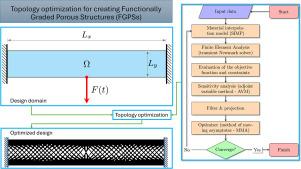Design of topology-optimized functionally graded porous structures under transient loads
IF 9.4
1区 工程技术
Q1 ENGINEERING, MECHANICAL
International Journal of Mechanical Sciences
Pub Date : 2024-09-21
DOI:10.1016/j.ijmecsci.2024.109732
引用次数: 0
Abstract
This paper presents a novel approach for designing functionally graded porous structures (FGPSs) at a macroscopic scale, where the main goal is to maximize their stiffness when subjected to time varying loads. Topology optimization is used to achieve the complex task of designing the size, shape, and distribution of pores in porous structures. We employ a local volume constraint that smoothly varies in space, leading to the formation of a graded structure consisting of varying sizes and shapes of solid and empty regions. Further constraints, such as global volume and static compliance, are incorporated into the optimization framework to improve the results. The modified solid isotropic material with penalization (SIMP) model is applied to interpolate the material properties. The design variables are filtered, and the projection technique is employed to obtain black-and-white topologies. The method of moving asymptotes (MMA) solves the optimization problem, which is a gradient-based algorithm. Sensitivities are computed using the adjoint variable method (AVM) within the discretize-then-differentiate strategy. The linear elastodynamic problem resulting from the transient finite element analysis (FEA) is solved with the implicit Newmark- scheme. Several numerical examples are provided to demonstrate the effectiveness of the proposed approach in producing multiple closed- and open-cell composite foams tailored to specific design criteria. The optimized FGPSs have the potential to fulfill the requirements for both lightweight and energy absorption in applications subjected to dynamic loads, such as those found in the automotive, aerospace and biomedical industries.

瞬态载荷下拓扑优化的功能分级多孔结构设计
本文提出了一种在宏观尺度上设计功能分级多孔结构(FGPS)的新方法,其主要目标是在承受随时间变化的载荷时最大限度地提高多孔结构的刚度。拓扑优化用于完成设计多孔结构中孔隙的大小、形状和分布的复杂任务。我们采用了在空间中平滑变化的局部体积约束,从而形成了由不同大小和形状的实心和空心区域组成的分级结构。我们还将全局体积和静态顺应性等其他约束条件纳入优化框架,以改进结果。修正的各向同性实心材料(SIMP)模型用于对材料属性进行插值。对设计变量进行过滤,并采用投影技术获得黑白拓扑结构。移动渐近线法(MMA)是一种基于梯度的算法,用于解决优化问题。在先离散后微分的策略下,使用邻接变量法(AVM)计算敏感性。瞬态有限元分析(FEA)产生的线性弹性动力学问题采用隐式 Newmark-β 方案求解。我们提供了几个数值示例,以证明所提出的方法在生产符合特定设计标准的多种闭孔和开孔复合泡沫方面的有效性。优化后的 FGPS 有可能满足汽车、航空航天和生物医疗行业等承受动态载荷的应用对轻质和能量吸收的要求。
本文章由计算机程序翻译,如有差异,请以英文原文为准。
求助全文
约1分钟内获得全文
求助全文
来源期刊

International Journal of Mechanical Sciences
工程技术-工程:机械
CiteScore
12.80
自引率
17.80%
发文量
769
审稿时长
19 days
期刊介绍:
The International Journal of Mechanical Sciences (IJMS) serves as a global platform for the publication and dissemination of original research that contributes to a deeper scientific understanding of the fundamental disciplines within mechanical, civil, and material engineering.
The primary focus of IJMS is to showcase innovative and ground-breaking work that utilizes analytical and computational modeling techniques, such as Finite Element Method (FEM), Boundary Element Method (BEM), and mesh-free methods, among others. These modeling methods are applied to diverse fields including rigid-body mechanics (e.g., dynamics, vibration, stability), structural mechanics, metal forming, advanced materials (e.g., metals, composites, cellular, smart) behavior and applications, impact mechanics, strain localization, and other nonlinear effects (e.g., large deflections, plasticity, fracture).
Additionally, IJMS covers the realms of fluid mechanics (both external and internal flows), tribology, thermodynamics, and materials processing. These subjects collectively form the core of the journal's content.
In summary, IJMS provides a prestigious platform for researchers to present their original contributions, shedding light on analytical and computational modeling methods in various areas of mechanical engineering, as well as exploring the behavior and application of advanced materials, fluid mechanics, thermodynamics, and materials processing.
 求助内容:
求助内容: 应助结果提醒方式:
应助结果提醒方式:


